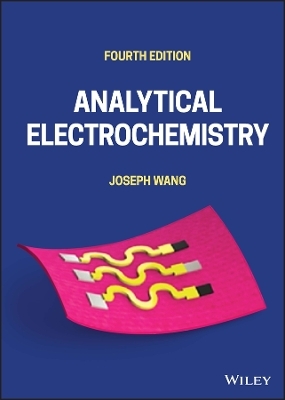
Analytical Electrochemistry
John Wiley & Sons Inc (Verlag)
978-1-119-78769-3 (ISBN)
In the newly revised 4th edition of Analytical Electrochemistry, distinguished researcher Dr. Joseph Wang delivers an authoritative and comprehensive discussion of modern electroanalytical techniques and devices. With a strong focus on electroanalysis (as opposed to physical electrochemistry), the book offers readers a thorough grounding in the fundamentals of electrode reactions and the principles of electrochemical methods. It also demonstrates the solving of real-life analytical problems using the techniques discussed within.
This latest edition contains extensive updates to the cited literature and its descriptions of various electrochemical processes and techniques. Additional worked examples are included in the text and numerous quantitative questions and exercise problems are found at the end of each chapter.
Readers will also find:
A thorough introduction to the fundamental concepts of electroanalysis, including discussions of Faradaic processes, electrical double layers, and the electrocapillary effect
Comprehensive explorations of the study of electrode reactions, interfacial properties, and controlled potential techniques
Practical discussions of the practical considerations of electroanalysis, including electrochemical cells, solvents and supporting electrolytes, and instrumentation
Detailed treatments of potentiometry and electrochemical sensors, including ion selective electrodes, electrochemical biosensors and wearable devices
Perfect for graduate students studying electroanalytical chemistry, Analytical Electrochemistry will also benefit advanced undergraduate students taking courses in instrumental analysis, as well as academics and industrial professionals considering the use of electroanalysis in their labs.
Joseph Wang, PhD, is Distinguished Professor, SAIC Endowed Chair and Chair in the Department of Nanoengineering at University of California, San Diego (UCSD). He is the Director of the UCSD Center of Wearable Sensors and Founding Editor of Electroanalysis. He is a Fellow of the ECS, Royal Society of Chemistry, and the American Institute of Medical and Biological Engineering.
Preface ix
Abbreviations and Symbols xi
1 Fundamental Concepts 1
1.1 Why Electroanalysis? 1
1.2 Faradaic Processes 2
1.2.1 Mass-Transport-Controlled Reactions 4
1.2.1.1 Potential-Step Experiment 6
1.2.1.2 Potential Sweep Experiments 7
1.2.2 Reactions Controlled by the Rate of Electron Transfer 9
1.2.2.1 Activated Complex Theory 12
1.3 Electrical Double Layer 14
1.4 Electrocapillary Effect 18
1.5 Supplementary Reading 19
References 20
Questions 21
2 Study of Electrode Reactions and Interfacial Properties 22
2.1 Cyclic Voltammetry 22
2.1.1 Data Interpretation 24
2.1.1.1 Reversible Systems 24
2.1.1.2 Irreversible and Quasi-reversible Systems 25
2.1.2 Study of Reaction Mechanisms 26
2.1.3 Study of Adsorption Processes 29
2.1.4 Quantitative Applications – Fast-Scan Cyclic Voltammetry 30
2.2 Spectroelectrochemistry 32
2.2.1 Experimental Arrangement 32
2.2.2 Principles and Applications 33
2.2.3 Electrochemiluminescence 35
2.2.4 Optical Probing of Electrode/Solution Interfaces 36
2.3 Scanning Probe Microscopy 37
2.3.1 Scanning Tunneling Microscopy 37
2.3.2 Atomic Force Microscopy 38
2.3.3 Scanning Electrochemical Microscopy 40
2.4 Electrochemical Quartz Crystal Microbalance 43
2.5 Impedance Spectroscopy 45
References 47
Examples 50
Questions 52
3 Controlled-Potential Techniques 54
3.1 Chronoamperometry 54
3.2 Polarography 56
3.3 Pulse Voltammetry 59
3.3.1 Normal-Pulse Voltammetry 59
3.3.2 Differential-Pulse Voltammetry 60
3.3.3 Square-Wave Voltammetry 62
3.3.4 Staircase Voltammetry 65
3.4 AC Voltammetry 66
3.5 Stripping Analysis 67
3.5.1 Anodic Stripping Voltammetry 68
3.5.2 Potentiometric Stripping Analysis 71
3.5.3 Adsorptive Stripping Voltammetry and Potentiometry 72
3.5.4 Cathodic Stripping Voltammetry 74
3.5.5 Abrasive Stripping Voltammetry 75
3.5.6 Applications 75
3.6 Flow Analysis 75
3.6.1 Principles 77
3.6.2 Cell Design 79
3.6.3 Mass Transport and Current Response 81
3.6.4 Detection Modes 83
References 85
Examples 88
Questions 90
4 Practical Considerations 93
4.1 Electrochemical Cells 93
4.2 Solvents and Supporting Electrolytes 95
4.3 Oxygen Removal 95
4.4 Instrumentation 96
4.5 Working Electrodes 101
4.5.1 Mercury Electrodes 102
4.5.2 Solid Electrodes 103
4.5.2.1 Rotating Disk and Ring-Disk Electrodes 104
4.5.2.2 Carbon Electrodes 106
4.5.2.3 Metal Electrodes 109
4.5.3 Printed Electrodes and Devices 110
4.5.3.1 Planar Screen-Printed Electrodes 110
4.5.3.2 3D-Printed Electrochemical Cells and Electrodes 112
4.5.4 Chemically Modified Electrodes 113
4.5.4.1 Self-Assembled Monolayers 114
4.5.4.2 Carbon-Nanotube-Modified Electrodes 115
4.5.4.3 Graphene-Based Electrodes 116
4.5.4.4 Sol–Gel Encapsulation of Reactive Species 117
4.5.4.5 Electrocatalytic Modified Electrodes 117
4.5.4.6 Preconcentrating Electrodes 118
4.5.4.7 Permselective Coatings 119
4.5.4.8 Conducting Polymers 122
4.5.5 Microscale and Nanoscale Electrodes 124
4.5.5.1 Diffusion at Microelectrodes 126
4.5.5.2 Configurations of Microelectrodes 126
4.5.5.3 Composite Electrodes 128
4.5.6 Microneedle Electrodes and Arrays 130
References 132
Examples 137
Questions 137
5 Potentiometry 139
5.1 Principles of Potentiometric Measurements 139
5.2 Ion-Selective Electrodes 145
5.2.1 Glass Electrodes 145
5.2.1.1 pH Electrodes 145
5.2.1.2 Glass Electrodes for Other Cations 148
5.2.2 Liquid Membrane Electrodes 148
5.2.2.1 Ion-Exchanger Electrodes 150
5.2.2.2 Neutral Carrier Electrodes 151
5.2.3 Solid-State Electrodes 154
5.2.4 Solid-Contact ISE: Eliminating the Internal Filling Solution 157
5.3 On-line, On-site, In Situ, and In Vivo Potentiometric Measurements 160
References 164
Examples 167
Questions 168
6 Electrochemical Sensors 170
6.1 Electrochemical Biosensors 171
6.1.1 Enzyme‐Based Electrodes 171
6.1.1.1 Practical and Theoretical Considerations 171
6.1.1.2 Enzyme Electrodes of Analytical Significance 175
6.1.2 Affinity Biosensors 182
6.1.2.1 Immunosensors 182
6.1.2.2 Aptamer‐Based Electrochemical Biosensors 185
6.1.2.3 DNA Hybridization Biosensors 186
6.1.2.4 Electrochemical Sensors Based on Molecularly Imprinted Polymers 189
6.2 Gas Sensors 189
6.2.1 Carbon Dioxide Sensors 190
6.2.2 Oxygen Electrodes 191
6.3 Solid-State Devices 192
6.3.1 Ion‐Selective Field Effect Transistors 192
6.3.2 Microfabrication of Solid‐State Sensor Assemblies 194
6.3.3 Photolithographic Sensor Fabrication Techniques 194
6.3.4 Micromachined Analytical Microsystems 195
6.3.5 Paper‐Based Electroanalytical Devices 196
6.4 Sensor Arrays 197
6.5 Wearable Electrochemical Sensors 200
References 203
Examples 210
Questions 211
Index 213
| Erscheinungsdatum | 06.03.2023 |
|---|---|
| Verlagsort | New York |
| Sprache | englisch |
| Gewicht | 776 g |
| Themenwelt | Naturwissenschaften ► Chemie ► Technische Chemie |
| Technik | |
| ISBN-10 | 1-119-78769-6 / 1119787696 |
| ISBN-13 | 978-1-119-78769-3 / 9781119787693 |
| Zustand | Neuware |
| Informationen gemäß Produktsicherheitsverordnung (GPSR) | |
| Haben Sie eine Frage zum Produkt? |
aus dem Bereich


